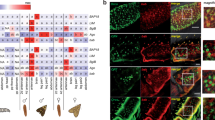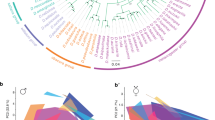Abstract
InDrosophila melanogaster, male wing vibration, a key element of courtship behaviour, is most efficiently induced by a female-specific contact pheromonecis, cis 7,11 heptacosadiene (7, 11 HD), which is the main mature female cuticular hydrocarbon in the CS laboratory strain. A study of 63 strains from around the world revealed that flies from Sub-Saharan Africa and the Caribbean are unique in showing low levels 7,11 HD and high levels of the position isomer 5,9 HD. This difference maps to chromosome III, perhaps indicating a simple genetic control of the 7,11 HD: 5,9 HD ratio. Females from strains with high levels of 7,11 HD showed higher levels of mating and mated more rapidly than females with low levels of 7,11 HD. The results are discussed in light of recent discoveries of genetic differences betweenD. melanogaster strains from Africa and those from elsewhere around the world.
Similar content being viewed by others
References
Antony, C. & J.-M. Jallon, 1982. The chemical basis for sex recognition inDrosophila melanogaster. J. Insect Physiol. 28: 873–880.
Antony, C., T. L. Davis, D. A. Carlson, J.-M. Péchiné & J.-M. Jallon, 1985. Compared behavioral responses of maleDrosophila melanogaster (Canton S) to natural and synthetic aphrodisiaes. J. Chem. Ecol. 11: 1617–1629.
Ashburner, M., 1989.Drosophila: A laboratory handbook. (Cold Spring Harbor: Cold Spring Harbor Laboratory Press).
Bauer, S. J. & M. B. Sokolowski, 1985. A genetic analysis of path length and pupation height in a natural population ofDrosophila melanogaster. Can. J. Genet. Cytol. 27: 334–340.
Begun, D. J. & C. F. Aquadro, 1993. African and North American population ofDrosophila melanogaster are very different at the DNA level. Nature 364: 548–550.
van den Berg, M. J., G. Thomas, H. Hendriks & W. van Velden, 1984. A reexamination of the negative assortative mating phenomenon and its underlying mechanism inDrosophila melanogaster. Behav. Genet. 14: 45–61.
Cobb, M. & J.-M. Jallon, 1990. Pheromones, mate recognition and courtship stimulation in theDrosophila melanogaster species sub-group. Anim. Behav. 39: 1058–1067.
Cobb, M., B. Burnet & K. Connolly, 1988. Sexual isolation and courtship behavior inDrosophila simulans, D. mauritiana, and their interspecific hybrids. Behav. Genet. 18: 211–225.
Cobb, M., B. Burnet, R. Blizard & J.-M. Jallon, 1990. Altered mating behavior in a Carsonian population ofDrosophila sechellia. Evolution 44: 2057–2068.
Cohet, Y. & J. R. David, 1980. Geographic divergence and sexual behaviour: Comparison of mating systems in French and Afrotropical populations ofDrosophila melanogaster. Genetica 54: 161–165.
Connolly, K., B. Burnet, M. Kearny & L. Eastwood, 1974. Mating speed and courtship behaviour of inbred strains ofDrosophila melanogaster. Behaviour 48: 61–74.
Coyne, A. J., A. P. Crittenden & K. Mah, 1994. Genetics of a pheromonal difference contributing to reproductive isolation inDrosophila. Science 265: 1461–1464.
David, J. R. & P. Capy, 1988. Genetic variation ofDrosophila melanogaster natural populations. Trends Genet 4: 106–111.
Eastwood, L. & B. Burnet 1977. Courtship latency in maleDrosophila melanogaster. Behav. Genet. 7: 359–372.
Ewing, A., 1983. Functional aspects ofDrosophila courtship. Biol. Rev. 58: 275–292.
Ferveur, J.-F., 1991. Genetic control of pheromones inDrosophila simulans. I. Ngbo, a locus on the second chromosome. Genetics 128: 293–301.
Giddings, L. V. & A. R. Templeton, 1983. Behavioral phylogenies and the direction of evolution. Science 220: 372–378.
Henderson, N. R. & D. M. Lambert, 1982. No significant deviation from random mating of world-wide populations ofDrosophila melanogaster. Nature 300: 437–440.
Jallon, J.-M., 1984. A few chemical words exchanged byDrosophila during courtship and mating. Behav. Genet. 14: 441–476.
Jallon, J.-M. & J.-M. Péchiné, 1989. Une autre race chimique deDrosophila melanogaster en Afrique. C.R. Acad. Sci. Paris 309: 1551–1556.
Kaneshiro, K. Y., 1976. Ethological isolation and phyologeny in theplanitibia subgroup of HawalanDrosophila. Evolution30: 740–745.
Klun, J. A. & M. D. Huettel, 1988. Genetic regulation of sex pheromone production and response interaction of sympatric pheromonal types of European corn borer,Ostriana nubilatis (Lepidoptera: Pyralidae). J. Chem. Ecol. 14: 2047–2061.
Kyriacou, Ch. P. & J. C. Hall, 1984. Learning and memory mutations impair acoustic priming of mating behaviour inDrosophila. Nature 308, 62–65.
Lemeunier, F., J. R. David, L. Tsacas & M. Ashburner, 1986. Themelanogaster species group. In Genetics and Biology of Drosophila (Vol. 3E) (eds M. Ashburner, H. L. Carson & J. N. Thompson) pp. 147–256. London: Academic Press.
Löefstedt, C., B. S. Hansson, W. Roelfs & B. O. Bengtsson, 1989. No linkage between genes controlling female pheromone production and male pheromone response in the European corn borner,Ostrinia nubilalis Hûbner (Lepidoptera: Pyralidae). Genetics 123: 555–556.
Luyten, I., 1982. Variations intraspécifique et interspécifique des hydrocarbures cuticulaires chezDrosophila simulans et des espèces affines. C.R. Acad. Sci. Paris 295: 733–736.
Ringo, J. M., H. N. Dowse & S. Lagasse, 1986. Symmetry versus asymmetry in sexual isolation experiments. Evolution 40: 1071–1083.
von Schilcher, F., 1976. The rôle of auditory stimuli in the courtship ofDrosophila melanogaster. Anim. Behav. 24: 18–26.
Singh, R. S. & L. R. Rhomberg, 1987. A comprehensive study of genic variation in natural populations ofDrosophila melanogaster. I. Estimation of gene flow from rare alleles. Genetics 115: 313–322.
Toolson, E. C. & R. Kuper-Simbrón, 1989. Laboratory evolution of epicuticular hydrocarbon composition inD. pseudoobscura: effects on sexual dimorphism and thermal acclimation ability, Evolution 43: 468–473.
Venard, R., Antony, C. & J.-M. Jallon, 1989.Drosophila chemoreceptors. In Neurobiology of Sensory Systems (eds N. Singh & N. J. Strausfeld) pp. 377–385. New York: Plenum Press.
Watanabe, T. K. & M. Kawanishi, 1979. Mating preference and the direction of evolution inDrosophila. Science 205: 906–907.
Author information
Authors and Affiliations
Rights and permissions
About this article
Cite this article
Ferveur, JF., Cobb, M., Boukella, H. et al. World-wide variation inDrosophila melanogaster sex pheromone: behavioural effects, genetic bases and potential evolutionary consequences. Genetica 97, 73–80 (1996). https://doi.org/10.1007/BF00132583
Received:
Accepted:
Issue Date:
DOI: https://doi.org/10.1007/BF00132583




